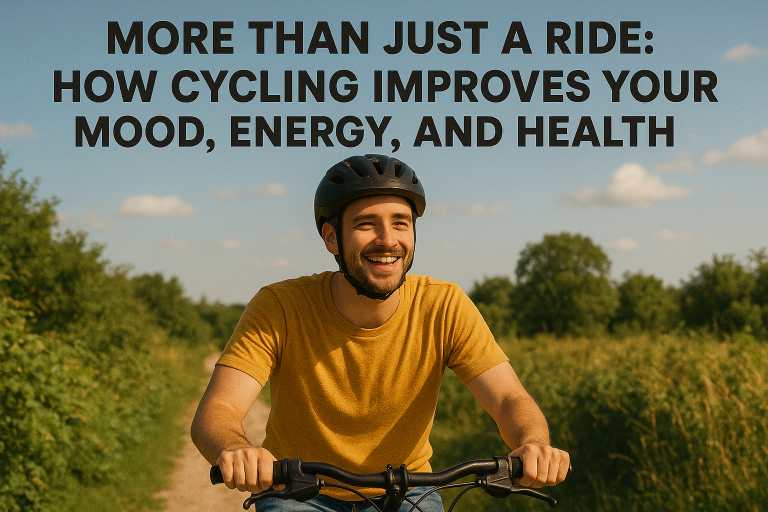Why Cycling Feels Easier Than Running (Even If It Burns Just as Many Calories)
When it comes to cardio workouts, running and cycling are two of the most popular choices. Both offer excellent cardiovascular benefits, burn calories, and improve overall fitness. However, many people find cycling significantly easier and more enjoyable than running, even though both exercises can burn a similar number of calories. Why does biking feel like a breeze while running often feels like a struggle? Let’s break it down.
- Less Impact on Joints
One of the biggest reasons cycling feels easier than running is the reduced impact on your joints. When you run, each step sends a shock through your ankles, knees, and hips. Over time, this repetitive impact can lead to soreness, discomfort, and even injuries. Cycling, on the other hand, is a low-impact exercise since your body weight is supported by the bike, making it much gentler on your joints. This is why people with joint pain or previous injuries often prefer biking over running.
- Momentum Does Some of the Work
Once you get going on a bike, momentum helps carry you forward with less effort. While you do need to keep pedaling, the rolling motion of the wheels reduces the amount of energy required compared to continuously lifting your entire body with each step while running. Running requires constant muscular effort to push off the ground, whereas cycling allows for moments of reduced effort, especially on flat surfaces or downhill sections.
- Easier to Maintain a Steady Pace
When you run, changes in terrain and fatigue can make it difficult to maintain a steady pace. Running requires your body to constantly adjust to varying conditions. On a bike, it’s much easier to maintain a consistent speed, especially with the help of gears. Gears allow you to adjust the resistance, making it easier to pedal uphill or coast when needed. This control makes cycling feel less exhausting than running, where slowing down often means stopping entirely.
- More Variety in Effort Levels
Cycling offers natural variations in effort. When you’re biking, you can alternate between high-intensity bursts and relaxed coasting without stopping the workout entirely. On the other hand, running requires sustained effort with very little opportunity to rest unless you completely stop or slow to a walk. The ability to control exertion levels makes cycling feel more manageable and less tiring over long distances.
- You Stay Cooler While Biking
Have you ever noticed that running makes you feel hotter than cycling, even in similar weather conditions? That’s because when you bike, you create your own wind resistance. The air moving past you helps cool your body and evaporate sweat more efficiently. When running, the body relies solely on perspiration to cool down, which can lead to overheating, especially in hot or humid conditions. This cooling effect can make cycling feel far more comfortable than running over extended periods.
- Psychological Perception of Effort
Perceived effort plays a big role in how we experience exercise. Cycling is often perceived as less strenuous because it allows you to move quickly with less perceived exertion. Covering a greater distance in a shorter time makes the workout feel more productive and rewarding. In contrast, running requires more effort to achieve the same distance, making it feel tougher even if the calorie burn is similar.
- Ability to Rest Without Stopping
In cycling, you can take short breaks while still moving forward. You can coast downhill, reduce pedaling intensity, or shift gears to make riding easier without stopping. In contrast, running requires continuous effort; even slowing down still demands significant exertion. This ability to “rest” while still progressing makes cycling feel less exhausting overall.
- Engaging More Muscle Groups Differently
While both cycling and running engage the lower body, they do so in different ways. Running heavily relies on repetitive impact forces on the same muscle groups, leading to quicker fatigue. Cycling, on the other hand, distributes effort more evenly through a combination of quadriceps, hamstrings, calves, and glutes. Additionally, cycling places less strain on stabilizing muscles, reducing the overall sense of exertion compared to running.
- Longer Workout Duration Without Excess Fatigue
Since cycling feels easier on the body, people can typically ride for longer periods than they can run. For example, a one-hour bike ride at a moderate pace is much more manageable than a one-hour continuous run. Because you can exercise for longer without feeling as exhausted, you may end up burning the same (or even more) calories compared to a shorter, more strenuous run.
- More Enjoyable and Less Mental Fatigue
Enjoyment plays a huge role in how difficult an exercise feels. Many people find cycling more enjoyable because it allows them to explore different areas, cover greater distances, and experience a sense of adventure. Running can sometimes feel repetitive and mentally exhausting, especially over long distances. The ability to explore new places on a bike can make workouts feel like an adventure rather than just exercise.
Conclusion: Both Are Great, but Cycling Feels Easier
While both cycling and running offer excellent health benefits, cycling often feels easier due to reduced impact, momentum assistance, natural cooling, and psychological factors. Because of this, many people find it easier to stick with cycling long-term, leading to greater consistency and, ultimately, better fitness results. If running feels like a struggle, switching to cycling might be the perfect way to keep moving without the excessive fatigue.
So, next time you’re debating between running and biking, consider hopping on a bike—it might just make your workout feel more enjoyable while still giving you the results you want!






Hi, this is a comment.
To get started with moderating, editing, and deleting comments, please visit the Comments screen in the dashboard.
Commenter avatars come from Gravatar.